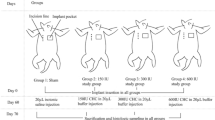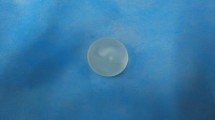Abstract
Background
Pirfenidone (PFD), a new antifibrotic and antiinflammatory agent, prevents and resolves fibrous tissue. This study evaluated the effect of PFD on adverse events in mammary implants using an animal model. Mammary implantation, the most frequent aesthetic surgery, may present several complications after surgery such as swelling, capsule contracture, hardness, and pain.
Methods
Wistar rats underwent submammary implantation with either smooth or textured silicone gel implants and were administrated 200 mg/kg of PFD daily. The control group received saline. The animals were killed at 8 weeks. The capsular tissue of both implants was removed for histologic and molecular analyses.
Results
Typical postaugmentation periimplant capsules with opacity on adjacent tissues developed 8 weeks after silicone implantation. No significant differences were observed between the textured and smooth implants in any analyzed parameter. Clearly, PFD reduced capsule thickness around submmamary tissue, fibroblast-like cell proliferation, and recruitment of inflammatory cells. The total cell numbers per field were reduced as well. In contrast, the control group presented abundant mononuclear cell infiltration and fibroblast-like cell proliferation. The total content of collagen in the PFD group was 50% less than in the control group. Fibroblast cells displayed 45% less activated phenotype in the PFD group than in the control group, as determined by immunohistochemistry techniques. In the PFD animals, transforming growth factor-β (TGF-β) decreased 85% and collagen 1 gene expression 60%, compared with the control group.
Conclusion
The findings show a positive effect of PFD on mammary contracture in 10 rats. Despite the small number of animals, the differences found in 10 control rats encourage the authors to propose a larger study later and to suggest PFD as a potential preventive strategy in human mammary implantation surgery.






Similar content being viewed by others
References
Burckhardt BR (1988) Capsular contracture: Hard breasts, soft data. Clin Plast Surg 15:521
Collis N, Coleman D, Foo ITH, Sharpe DT (2000) Ten years of a prospective randomised controlled trial of textured versus smooth subglandular silicone gel breast implants. Plast Reconstr Surg 106:786–791
Vistnes LM, Ksander GA, Kosek J (1978) Study of encapsulation of silicone rubber implants in animals: A foreign body reaction. Plast Reconstr Surg 62:580–588
Coleman DJ, Foo ITH, Sharpe DT (1991) Textured or smooth implants for breast augmentation? A prospective controlled trial. Br J Plast Surg 44:444– 448
Lossing C, Hanson HA (1981) Peptide growth factors and myofibroblast in capsules around human breast implants. Plast Reconstr Surg 91:1277–1286
Vistnes LM, Ksander GA, Isaacs G, Rozner L (1981) Elevated glycosaminoglycans and chondroitin 4–sulfate and other properties of contracted human prosthesis capsules. Ann Plast Surg 7:195–203
Kuhn A, Sing S, Smith PD (2000) Periprosthetic breast capsules contain the fibrogenic cytokines TGF-β1 and TGF-β2, suggesting possible new treatment approaches. Ann Plast Surg 44:387–391
Brohim RM, Foresman PA, Hildebrandt PK (1992) Early tissue reaction to textured breast implant surfaces. Ann Plast Surg 28:354
Lossing C, Hansson HA (1993) Peptide growth factors and myofibroblasts in capsules around human breast implants. Plast Reconstr Surg 91:1277–1286
Ajmal N, Riordan CL, Cardwell N, Nanney LB, Shack RB (2003) The effectiveness of sodium 2–mercaptoethane sulfonate (mesna) in reducing capsular formation around implants in a rabbit model. Plast Reconstr Surg 112:1455–1461
Frangou J, Kanellaki M (2001) The effect of local application of mitomycin C on the development of capsule around silicone implants in the breast: An experimental study in mice. Aesth Plast Surg 25:118–128
Eltze E, Bettendorf O, Rody A, Jackisch C, Herchenroder F, Bocker W, Pfleiderer B (2003) Influence of local complications on capsule formation around model implants in a rat model. J Biomed Mater Res 64A:12–19
Minami E, Jun Koh I, Ronche JC, Ferreira J, Logullo AF, Waitzberg A, Chifferi V, Fortoul-Rosewick T, Domínguez-Pereira M, Nascimento PH, Saldiva P, Poli de Figueiredo LF (2006) The composition and behavior of capsules around smooth and textured breast implants in pigs. Plast Reconstr Surg 118:874–884
Eltze E, Schafer U, Bettendorf O, Rody A, Herchenroder F, Chiwritsch T, Jackisch C, Pfleiderer B (2006) Radiation-induced capsule tissue reactions around textured breast implants in a rat model. Breast 15:331–338
Adams WP, Haydon MS, Raniere J, Trott S, Marques M, Feliciano M, Robinson JB, Tang L, Brown SA (2006) A rabbit model for capsular contracture: development and clinical implications. Plast Reconstr Surg 117:1214–1219
Cardenas-Camarena L, Paillet JC, Briseño R: Electrostimulation (2005) Uses and applications for periprosthetic capsular contracture: Experimental model. Aesth Plast Surg 29:410–414
Peterson HD, Burt GB Jr (1974) The role of steroid in prevention of circumferential capsular scarring in augmentation mammaplasty. Plast Reconstr Surg 54:28
Perrin ER (1976) The use of soluble steroid within inflatable breast prostheses. Plast Reconstr Surg 57:163
Vinnik CA (1976) Spherical contracture of fibrous capsules around breast implants: Prevention and treatment. Plast Reconstr Surg 58:555
Ellemberg AH (1977) Marked thinning of the breast skin flaps after the insertion of implants containing triamcinolone. Plast Reconstr Surg 60:755
Carrico TJ, Cohen IK (1979) Capsular contracture and steroid-related complication after augmentation mammaplasty: A preliminary study. Plast Reconstr Surg 64:377
Baker JL Jr (1981) The effectiveness of alpha-tocopherol (vitamin E) in reducing the incidence of spherical contracture around breast implants. Plast Reconstr Surg 68:696
Cucin RL, Guthrie RH, Graham M (1982) Rate of diffusion of Solu-Medrol across the silastic membranes of breast prostheses: An in vivo study. Ann Plast Surg 9:228
Cafee HH (1984) The effects of intraprosthetic methylprednisolone on implants capsules and surrounding soft tissue. Ann Plast Surg 12:348
Gayou R, Rudolph R (1979) Capsular contraction around silicone mammary prostheses. Ann Plast Surg 2:62
Iyer SN, Wild JS, Schiedt MJ, Hyde DM, Margolin SB, Giri SN (1995) Dietary intake of pirfenidone ameliorates bleomycin-induced lung fibrosis in hamsters. J Lab Clin Med 125:779–785
Al-Took S, Murray C, Tulandi T (1998) Effects of pirfenidone and dermoid cyst fluid on adhesion formation. Fertil Steril 69:341–342
García L, Hernandez I, Sandoval A, Salazar, Garcia J, Vera J, Grijalva G, Muriel P, Margolin S, Armendariz-Borunda J (2002) Pirfenidone affectively reverses experimental liver fibrosis. J Hepatol 32:797–805
Armendáriz-Borunda J, Islas-Carbajal MC, Meza-García E, Rincón AR, Sandoval AS, Salazar A, Berumen J, Alvarez A, Alvarez A, Covarrubias A, Aréchiga G, García L (2006) A pilot study in cirrhotic patients using a new antiinflammatory and antifibrotic agent, pirfenidone. Gut 55:1663–1665
Lee B-S, Margolin SB, Nowak AR (1998) Pirfenidone: A novel pharmacological agent that inhibits leiomyoma cell proliferation and collagen production. J Clin Endocrinol Metab 83:219–223
Shimizu T, Kuroda T, Hata S, Fukagawa M, Margolin SB, Kurokawa K (1998) Pirfenidone improves renal function and fibrosis in the postobstructed kidney. Kidney Int 54:99–109
Shetlar MR, Shetlar DJ, Bloom RF, Shetlar CL, Margolin SB (1998) Involution of keloid implants in athymic mice treated with pirfenidone or with triamcinolone. J Lab Clin Med 132:491–496
Callaway JK, Beart PM, Jarott B (1998) A reliable procedure for comparison of antioxidants in rat brain homogenates. J Pharmacol Toxicol Methods 39:155–162
Chomczynski P, Sacchi N (1987) Single-step method of RNA isolation by acid guanidinium thiocyanate-phenol chloroform extraction. Anal Biochem 162:156–159
Retrieved from http://www.dna-9.int-med.uiowa.edu/RealtimePCRdocs/Bulletin 2 Applied Byosystem
Fagrell D, Berggren A, Tarpila E (2001) Capsular contracture around saline-filled fine textured and smooth mammary implants: A prospective 7.5-year follow-up. Plast Reconstr Surg 108:2108
Lee B-S, Margolin SB, Nowak AR (1998) Pirfenidone: A novel pharmacological agent that inhibits leiomyoma cell proliferation and collagen production. J Clin Endocrinol Metab 83:219–223
Musters S, Coughlan K, McFadden T, Mapple R, Mulvey T, Plaunt K (2004) Exogenous TGF-β1 promotes stromal development in the heifer mammary gland. J Dairy Sci 87:896–904
Acknowledgment
This investigation was supported by Cell Therapy and Technology, S.A. de C.V.
Author information
Authors and Affiliations
Corresponding author
Rights and permissions
About this article
Cite this article
Gancedo, M., Ruiz-Corro, L., Salazar-Montes, A. et al. Pirfenidone Prevents Capsular Contracture After Mammary Implantation. Aesth Plast Surg 32, 32–40 (2008). https://doi.org/10.1007/s00266-007-9051-4
Published:
Issue Date:
DOI: https://doi.org/10.1007/s00266-007-9051-4




